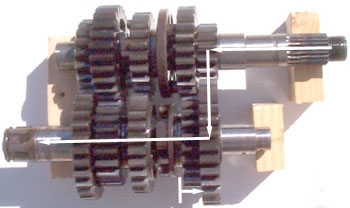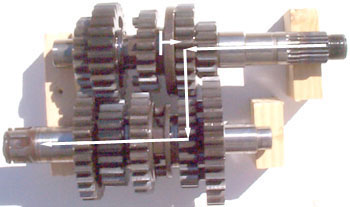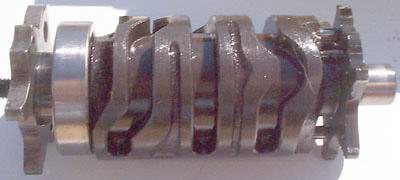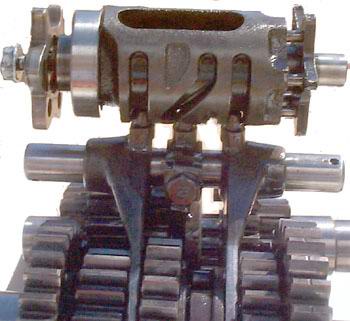while the XR was in pieces JAW grabs the camera and takes some happy snaps in order to share some understanding of how a motorbike gearbox works.
Power Flow.
Twisting power from the engine hits the gearbox via the clutch and spins the countershaft. You can see there are 5 cogs on the countershaft (top of photo) and these correspond to cogs on the mainshaft (bottom of photo), meshed together, each cog pair producing a different ratio. This box is... yeah okay, you guessed it, a 5 speed ;)
The "X" crosses mean the cog can free spin. At the moment in fact, the gearbox is in neutral. You'll notice for every cog that can free spin it's mate cannot - it is locked to the shaft. A locked cog can move backwards and forwards a little bit along the shaft it is on, but it always spins with the shaft it is attached to. This will make sense soon.

Power enters from the clutch onto the countershaft and leaves via one of the gear ratios out the sproket. "X" means this cog idles; ie is able to free spin.

A cog with it's (B) spline connection and (C) "lockers".
From the next photo you can see how a cog is locked to its shaft but can move from side to side - it is splined. Are ya with me? (A) shows the spline lumps on the shaft and (B) shows the corresponding inverted spline lumps in the cog.
(C), which we shall call a "locker" for want of a better term, performs the selection of a gear.
Lumps and holes... when a gear that is locked to the shaft gets told to "swing left" or "swing right" as the case may be, the locker mates with its next door neighbour cog. By an amazing coincidence, that cog is normally an idler, but once joined it too is locked to the shaft and therefore must spin with the shaft.
This is how gears are selected. The rider moves the cog across to its next door neighbour, when the locker lines up with the corresponding hole, in she clunks, locked together.

A cog and its neighbour - with
(B) spline connection and (C) "lockers".
Choose a Ratio.
First lets just consider neutral again. When in neutral, no cogs are locked together, so all gear ratios have one cog that is free spinning, and one cog that is locked to the shaft. What happens? Nothing! Power is fed via the clutch to the countershaft and can't do anything! (Note - the first picture on this page shows the gearbox in neutral).

First gear is selected.
But now when you select 1st gear, the bottom neighbour has slid to the right. Look carefully at the picture, it's the lower cog on the 4th gear that has moved right and locked. The top cog was already locked to the shaft, and thanks to lower 4th gear the bottom is now too. Nothing has happened to 4th gear, the top of 4th is still free-spinning. All the other cogs remain the same too.
The 1st gear top cog has 12 teeth, the bottom cog has 28. So now when power enters the countershaft 1st gear is selected and for every one revolution, the mainshaft does 12/28 = 0.43 revolutions. Yah, we're moving!
Examine the next 4 photos, each one represents a gear selection. In each case one of the selection cogs - ie those ones that don't free spin - has moved across to lock up with its neighbour. Note the when you change between gears the previously locked gear must first disengage before the new one can engage. Think about what would happen if two gears were selected at the same time... Ugly.
 |
 |
| Second gear is selected. | Third gear is selected. |
 |
 |
| Fourth gear is selected. | Fifth gear is selected. |
Selector forks.
Well this is all well and good JAW, but how does my left foot make it happen?

The selector forks in place.
Look at this picture, what you can see are the selector forks. They slot in on the selector cogs and push them left and right, right?
Those little stumps on the top of the selector forks are controlled by a programmed lump of metal known as the shift drum. Heh, there is a mechanical program running in your bike. Let's not refer to it as software though shall we...
Shift drum.

The brains of the situation - the shift drum.
And this is it. The deeper worm holes are where those little stumps fit in. By rotating the shift drum clockwise or counter clockwise it will push the selector forks left or right, depending on what the drum is "programmed" with.
The program has the first position having pushed the selector to 1st gear. Then, bring back the selector into neutral. Next push the second gear into place. Then, pull the second gear out of place and push third gear in. See - it is careful to take the previous gear out first before pushing the next one in. The arrangement of the gears, which seemed to be pretty random, is like some sort of gray code - you push one selector and pull another to change up or down. Okay, gray code is nerdy programmer talk, don't worry about it :)
So, together, it looks like this:

How the shift drum fits together. Very clever!
From the foot...

The stopper plate arrangement.
The final part of the picture is the rotation of the shift drum. On one end of the shift drum, the end with the bolt hanging out, is the star shaped stopper plate. It has a "clicker" wheel (the shift pawl) that holds the drum in position when a gear is selected. The shift pawl is just a small lever with a wheel on the end and a spring. When the wheel is in one of the "dents" in the stopper plate the spring force prevents it from slipping up or down a gear.
You can also see in this picture why getting the gearbox into neutral requires a little bit more precision than getting into the gears. The neutral position is out a bit higher and the "dent" isn't is big as the others. We want that however, so we can go from first gear to second gear without having to stop in neutral.

The selector spindle with "claw"
On the other end is the selector rod itself controlled by a little claw (on the right) that is moved by the gear lever. When you push down on the gear lever (the shaft in the bottom left of the photo) the little claw pushes the shift drum one stopper click clockwise, and vice versa. This push is enough to overcome the shift pawl spring force opn the other end of the drum. Each push is one gear - that's why motorbike boxes are sequential gear changers.
Notice here the broken part and thus why I had the gearbox out in the first place. Lucky for you otherwise I would never have written this story!
So now that you've seen it, and how "clunky" it is, you are gonna be nice to your gearbox and at least use the clutch in 1st and 2nd gear aren't you? ;)

From a different angle - you can see on the end
of the shift drum the "stopper plate".








 database
database